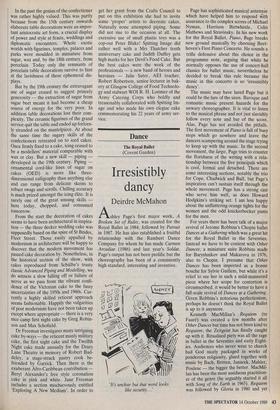Dance
The Royal Ballet (Covent Garden)
Irresistibly dancy
Deirdre McMahon
Ashley Page's first major work, A Broken Set of Rules, was created for the Royal Ballet in 1984, followed by Pursuit in 1987. He has also established a fruitful relationship with the Rambert Dance Company for whom he has made Carmen Arcadiae (1986) and last year's Soldat. Page's output has not been prolific but the choreography has been of a consistently high standard, interesting and inventive.
`It's unclear but that word looks like security...' Page has sophisticated musical antennae which have helped him to respond with assurance to the complex scores of Michael Nyman, Harrison Birtwhistle, Colin Mathews and Stravinsky. In his new work for the Royal Ballet, Piano, Rage breaks new ground musically by choosing Beet- hoven's First Piano Concerto. He sounds a trifle defensive about this choice in the programme note, arguing that while he normally opposes the use of concert-hall classics for ballet music, nevertheless he decided to break this rule because the music in this concerto is so 'irresistibly dancy'.
The music may have lured Page but it could be the lure of the siren. Baroque and romantic music present hazards for the unwary choreographer. It is vital to listen to the musical phrase and not just slavishly follow every note and bar of the score. Alas, Page has not avoided the pitfalls. The first movement of Piano is full of busy steps which go nowhere and leave the dancers scampering around the stage trying to keep up with the music. In the second movement, the largo, Page tries to counter the floridness of the writing with a rela- tionship between the five principals which is cool, formal and detached. There are some interesting sections, notably the trio for Cope, Chadwick and Bull, but Page's inspiration can't sustain itself through the whole movement. Page has a strong cast who serve him well, as does Howard Hodgkins's striking set. I am less happy about the unflattering orange tights for the women and the odd knickerbocker pants for the men.
For years there has been talk of a major revival of Jerome Robbins's Chopin ballet Dances at a Gathering which was a great hit for the Royal Ballet in the Seventies. Instead we have to be content with Other Dances, a miniature suite Robbins made for Baryshnikov and Makarova in 1976, also to Chopin. I presume that Other Dances has been imported as a bonne bouche for Sylvie Guillem, but while it's a relief to see her in such a mild-mannered piece where her scope for contortion is circumscribed, it would be better to have a full-scale revival of Dances at a Gathering. Given Robbins's notorious perfectionism, perhaps he doesn't think the Royal Ballet is up to it anymore. Kenneth MacMillan's Requiem (to Faure) was created a few months after Other Dances but time has not been kind to Requiem; the Zeitgeist has finally caught up with it. Ritualised piety was all the rage in ballet in the Seventies and early Eight- ies. Audiences who never went to church had God nicely packaged in works of ponderous religiosity, glued together with music by Bach, Britten, Janacek, Mahler, Poulenc — the bigger the better. MacMil- lan has been the most assiduous practition- er of the genre (he arguably started it all with Song of the Earth in 1965). Requiem was followed by Gloria in 1980 and yet another Requiem in 1986, this time to Lloyd Webber. I remember being impress- ed by Requiem when the Stuttgart Ballet brought it to London in 1978 but now it gives me toothache. Nothing dates more than saccharine sentiment and bogus piety, and the pop spirituality of Requiem now seems as antiquated as flower power and the summer of love. The audience is manipulated by the pompous message in the programme to refrain from applause (easily done). The atmosphere is so solemn and incense-laden, the dancers are so po-faced that one longed for Dame Edna to come and liven things up. I prefer my religion straight.



























































 Previous page
Previous page